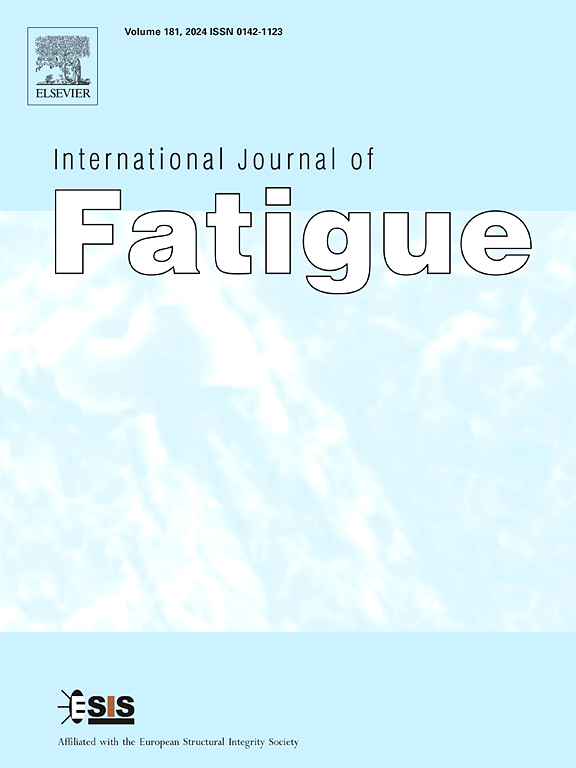Fatigue crack initiation in additively manufactured maraging steel: A statistical insight
IF 5.7
2区 材料科学
Q1 ENGINEERING, MECHANICAL
引用次数: 0
Abstract
High cycle fatigue tests were performed on three different-sized, laser powder bed fusion (L-PBF) fabricated MS1 maraging steel specimens at room temperature and at a stress ratio of −1, with qualitative and statistical investigation of the defect size and shape on the fatigue lives. The mechanical and fatigue properties were not much affected by the change in gauge volumes (128, 250, 432 mm3) investigated in this study owing to the similar distribution of the internal porosities. Interestingly, the manufacturing defects were mostly present near the free surface of the L-PBF fabricated parts instead of being uniformly distributed within the control volume. A significant scatter in the fatigue life data was attributed to the geometric parameters: shape, size, and location of the crack-initiating defects within the fractured specimens. The ratio of the defects’ size to their location with respect to the free surface was found to dictate the total fatigue life. The probabilistic S-N curves based on two popular models: the Weibull model and the Stüssi model, were plotted in addition to the conventional Murakami’s model to predict the fatigue life and strength. Conclusively, the Stüssi Model appeared to generate a safer fatigue design curve with the broadest bandwidth covering the experimentally observed uncertainties. The obtained results showed a good correlation with the experimental results and established the reliability of the research.

增材制造马氏体时效钢的疲劳裂纹萌生:统计学见解
在室温和应力比为- 1的条件下,对三种不同尺寸的激光粉末床熔合(L-PBF)制备的MS1马氏体时效钢试样进行了高周疲劳试验,定性和统计研究了缺陷尺寸和形状对疲劳寿命的影响。由于内部孔隙率分布相似,本研究中所研究的厚度(128,250,432 mm3)的变化对机械和疲劳性能的影响不大。有趣的是,制造缺陷大多出现在L-PBF制件的自由表面附近,而不是均匀分布在控制体积内。疲劳寿命数据的显著分散归因于几何参数:断裂试样中裂纹引发缺陷的形状、大小和位置。缺陷的尺寸与其相对于自由表面的位置之比决定了总疲劳寿命。在传统的村上模型的基础上,绘制了基于Weibull模型和st ssi模型的概率S-N曲线来预测疲劳寿命和强度。最后,st ssi模型似乎产生了一个更安全的疲劳设计曲线,具有最宽的带宽,覆盖了实验观察到的不确定性。所得结果与实验结果具有良好的相关性,建立了研究的可靠性。
本文章由计算机程序翻译,如有差异,请以英文原文为准。
求助全文
约1分钟内获得全文
求助全文
来源期刊

International Journal of Fatigue
工程技术-材料科学:综合
CiteScore
10.70
自引率
21.70%
发文量
619
审稿时长
58 days
期刊介绍:
Typical subjects discussed in International Journal of Fatigue address:
Novel fatigue testing and characterization methods (new kinds of fatigue tests, critical evaluation of existing methods, in situ measurement of fatigue degradation, non-contact field measurements)
Multiaxial fatigue and complex loading effects of materials and structures, exploring state-of-the-art concepts in degradation under cyclic loading
Fatigue in the very high cycle regime, including failure mode transitions from surface to subsurface, effects of surface treatment, processing, and loading conditions
Modeling (including degradation processes and related driving forces, multiscale/multi-resolution methods, computational hierarchical and concurrent methods for coupled component and material responses, novel methods for notch root analysis, fracture mechanics, damage mechanics, crack growth kinetics, life prediction and durability, and prediction of stochastic fatigue behavior reflecting microstructure and service conditions)
Models for early stages of fatigue crack formation and growth that explicitly consider microstructure and relevant materials science aspects
Understanding the influence or manufacturing and processing route on fatigue degradation, and embedding this understanding in more predictive schemes for mitigation and design against fatigue
Prognosis and damage state awareness (including sensors, monitoring, methodology, interactive control, accelerated methods, data interpretation)
Applications of technologies associated with fatigue and their implications for structural integrity and reliability. This includes issues related to design, operation and maintenance, i.e., life cycle engineering
Smart materials and structures that can sense and mitigate fatigue degradation
Fatigue of devices and structures at small scales, including effects of process route and surfaces/interfaces.
 求助内容:
求助内容: 应助结果提醒方式:
应助结果提醒方式:


